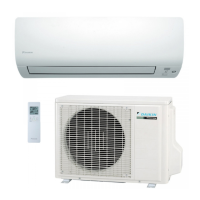What to do if my Daikin FTXS35DAVMW(L) Air Conditioner indoor unit smells bad?
- TTeresa MorganAug 7, 2025
If your Daikin Air Conditioner's indoor unit is emitting an odor, it is recommended to have the indoor unit cleaned by a technician.
What to do if my Daikin FTXS35DAVMW(L) Air Conditioner indoor unit smells bad?
If your Daikin Air Conditioner's indoor unit is emitting an odor, it is recommended to have the indoor unit cleaned by a technician.
Why is my Daikin FTXS35DAVMW(L) Air Conditioner outdoor unit emitting water or steam?
If your Daikin Air Conditioner's outdoor unit is emitting water or steam, this is normal. In HEAT mode, frost on the outdoor unit melts into water or steam during defrost operation. In COOL or DRY mode, moisture in the air condenses into water on the cool surface of the outdoor unit piping and drips.
Why does mist come out of my Daikin FTXS35DAVMW(L) indoor unit?
Mists coming out of the Daikin Air Conditioner's indoor unit can occur when the air in the room is cooled into mist by the cold airflow during cooling operation.
Why does the outdoor fan on my Daikin FTXS35DAVMW(L) Air Conditioner keep running when it's off?
If the outdoor fan of your Daikin Air Conditioner rotates even when the unit is not in operation, this is normal. After stopping the operation, the fan may continue rotating for 60 seconds for system protection. Also, when the outdoor temperature is very high, the fan might start rotating for system protection.
What to do if my Daikin FTXS35DAVMW(L) operation stopped suddenly but the OPERATION lamp is on?
If your Daikin Air Conditioner stops suddenly and the OPERATION lamp is on, it will automatically resume operation in about 3 minutes.
What to do if my Daikin FTXS35DAVMW(L) Air Conditioner heating stops and I hear a flowing sound?
If the heating operation of your Daikin Air Conditioner stops suddenly and a flowing sound is heard, please wait for about 3 to 8 minutes.
Essential precautions for safe operation and repair of the air conditioner, classified into warnings and cautions.
Detailed safety warnings specifically for repair work, covering electrical hazards and refrigerant handling.
Technical specifications for the cooling-only models, including capacity, power, and dimensions.
Technical specifications for the heat pump models, detailing cooling and heating performance.
Covers detection of malfunctions like insufficient gas, and specific controls like forced operation and facility settings.
A guide to identifying and resolving common operational problems and symptoms.
Lists common symptoms with corresponding checks and measures for diagnosing unit malfunctions.
Explains diagnostic modes, error code interpretation, and general troubleshooting guidance.
Troubleshooting for compressor overload, lock, fan lock, over current, valve, discharge pipe temp, and high pressure controls.
Step-by-step instructions for disassembling and removing parts of the indoor unit.
Instructions for removing external panels, fan motor, reactor, and other components of the outdoor unit.
| Brand | Daikin |
|---|---|
| Model | FTXS35DAVMW(L) |
| Category | Air Conditioner |
| Language | English |












